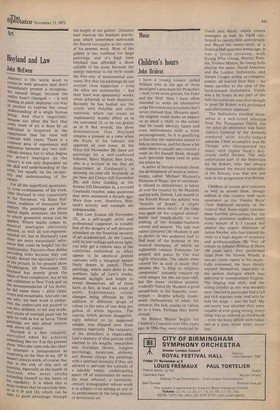Art
Hoyland and Law
John McEwen
Abstract is the worst word to reconcile with pictures that don't immediately present a recognisably natural image, because the reality hasn't changed: o is still looking at paint, deployea one way or another to express the visual understanding of a single human being, And that's important, because too often the fact that every work of art is done by an individual is forgotten in the expectation that his view will coincide with yours. There is a common area of experience and aspiration between any two individuals always, but to what degree the artist's impinges on the viewer's is not only dependent on the skill and understanding of the artist, but equally on the receptivity and understanding of the viewer.
For all the superficial spontaneity, even recklessness, of his work, John Hoyland is very consciously in the European, via Hans HofMann, tradition of measured formalism. His paintings are about Spatial depth, structure, the limits
to which geometric stress can be applied. Where Maths comes in, Musical analogies .obviously abound, as with all non-representational art, but in Hoyland's case them are more naturalistic references that could be helpful for the traditionalist. Painters often dislike Providing titles because they can totally distort the spectator's view of the picture. In his present show (Waddington till November 22) HoYland has merely given the dates of final completion, but at his last exhibition in New York and on the recommendation of his dealer, he did name them — after cities, rivers and mountains. And one can S ee why: his best work is embattled, the undercoats are poured to run into dribbles, to silt and erode, and crusts of overlaid paint can be split by reds as hot as larva. These Paintings are also about texture and, above all, colour. Hoyland is a fine colourist, unrivalled when he achieves something like no. 8 in the present show. Who else uses reds like that? Or attempts a juxtaposition as surprising as the blue in no. 10? It doesn't always work, of course, but that is the risk of this sort of Painting, especially in the hands of HoYland, who never shirks extending himself to the limits of his capal?ility. It is when this is Most evident that he succeeds best, as in 6 (8 and 14), which can be seen to good advantage through the length of the gallery. Distance here resolves the hesitant patchiness which sometimes surrounds the flawed rectangles at the centre of his present work. Most of the gallery is too confined for large paintings, and it's high time Hoyland was afforded a show suitable to his scale, because the energy essential to his style needs the free-rein of monumental canvases. Not that his paintings do not warrant close inspection — even the sides are noteworthy — but their hard won sponaneity works, when achieved, at both distances. Recently he has bodied out the acrylic with Polyfilla and other materials, which can create an unpleasantly mushy effect as in the untreated 13, or be too grainy as in 9. But overall, the show demonstrates that Hoyland remains a pioneer at a time when the fruits of his labours are apparent all over town. At the Hoya (till November 29) there are paintings by a self-confessed follower, Barry Martin; Bert Irvin, who is a lecturer in the fine art department at Goldsmith's, is showing six-year-old Hoylands at ,the New Art Centre (till November 29); and John Golding at the Rowan (till December 4), a revered Courtauld teacher, asks questions that were answered a decade ago. More than ever, therefore, Hoyland's activity and example are indispensable.
Bob Law (Lisson till November 15), as a self-taught artist and professional carpenter, is notably free of the dangers of self-delusion attendant on the financial security of art academicism. At the Lisson, with its low ceilings and neon light, you only get a remote idea of the subtleties embodied in what appear to be identical primed canvases with a marginal square finely drawn in pencil. These paintings, which were done in the northern light of Law's studio, demand daylight and height to reveal themselves. All of them have, in fact, at least six coats of paint, hypersensory colour changes being effected by the addition of different drops of colour to the ratio of one drop per gallon of white liquitex. The canvas, which proved disappointingly inferior to its supposed sample, was shipped over from America especially. The carpentry of the stretchers is impeccable. Law's mastery of that precise craft married to his lengthy researches into Euclidian theory, Jungian psychology, mysticism, alchemy and dreams charge his paintings with a spiritual intensity if they are allowed to pervade the solitude of a suitably empty, undistracting space. Of all minimalists he seems the most ethereal, a twentiethcentury iconographer whose work is as subject to its setting as any of its predecessors in the long history of devotional art.


































 Previous page
Previous page